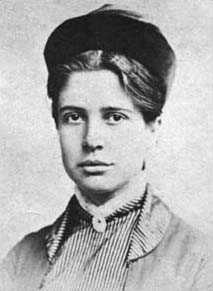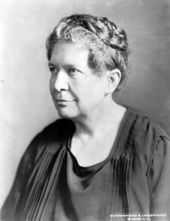Florence Kelley
| Florence Kelley | |
|---|---|
 | |
| Born |
September 12, 1859 Philadelphia, Pennsylvania |
| Died |
February 17, 1932 (aged 72) Philadelphia, Pennsylvania |
| Occupation | American social reformer |
| Spouse(s) | Lazare Wischnewetzky |
| Parent(s) | William D. Kelley and Caroline Bartram-Bonsall |
Florence Kelley (September 12, 1859 – February 17, 1932) was a social and political reformer. Her work against sweatshops and for the minimum wage, eight-hour workdays,[1] and children's rights[2] is widely regarded today. From its founding in 1899, Kelley served as the first general secretary of the National Consumers League. In 1909 Kelley helped create the National Association for the Advancement of Colored People (NAACP).
Family
Florence was the daughter of William D. Kelley (1814–1890) of Philadelphia, the son of Hannah and David Kelley and a self-made man who become an abolitionist, a founder of the Republican party, judge, and longtime member of the United States House of Representatives. Florence had two brothers and five sisters; all five sisters died in childhood. Three of the sisters were Josephine Bartram Kelley, Caroline Lincoln Kelley, and Anna Caroline Kelley. Josephine died at the age of 10 months. Caroline died at the age of four months. Anna died at six years of age.
Florence Kelley was an early supporter of women's suffrage after her sisters died and worked for numerous political and social reforms, including the NAACP (which Florence helped found). In Zurich, she met various European socialists, including Polish-Russian medical student Lazare Wischnewetzky, whom she married in 1884 and with whom she had three children [3] (the couple divorced in 1891). She is known for her translation of Die Lage der arbeitenden Klasse in England, written in 1844 by Friedrich Engels, with whom she corresponded. As The Condition of the Working Class in England in 1844,[4] it has been in print ever since. She appears there as 'Mrs. F. Kelley Wischnewetzky' and was also known as Florence Kelley.
Socialism and Civil Rights
Kelley studied at Cornell University from 1876 to 1882, graduating with the class of 1882. She attained Phi Beta Kappa Society honors, before taking up post-graduate studies at the University of Zurich. She was a member of the Intercollegiate Socialist Society, an activist for woman suffrage and African-American civil rights. She was a follower of Karl Marx and a friend of Friedrich Engels whose book, The Condition of the Working Class in England, she translated into English. The translation she made is still used today.
She assisted with the establishment of the New Century Guild of Philadelphia, along with Gabrielle D. Clements and led by Eliza Sproat Turner. It had classes and programs to assist working women.[5]
Factory inspection and child labor
Kelley's father had toured her through glass factories at night when she was young. Kelley fought to make it illegal for children under the age of 14 to work and to limit the hours of children under 16. She sought to give them the right of education, arguing children must be nurtured to be intelligent people.
From 1891 through 1899, Kelley lived at the Hull House settlement in Chicago, where in 1893, Governor Peter Altgeld made her the Chief Factory Inspector for the state of Illinois, a newly created position and unheard-of for a woman.[6] Hull House resident Alzina Stevens served as one of Kelley's assistant factory inspectors.[7] In the course of her Hull House work, she befriended Frank Alan Fetter when he was asked by the University of Chicago to conduct a study of Chicago neighborhoods. At Fetter's motion, she was made a member of Cornell's Irving Literary Society as an alumna, when he joined the Cornell Faculty.[8]
Kelley was known for her firmness and fierce energy. Hull House founder Jane Addams' nephew called Kelley "the toughest customer in the reform riot, the finest rough-and-tumble fighter for the good life for others, that Hull House ever knew."[9]
In 1913, she studied the federal patterns of distribution of funds for education. She noticed a lot of inequitable distributions for White schools as opposed to Black schools (Athey, 1971). This launched her to create the “The Sterling Discrimination Bill” which was an attack against the Sterling Towner Bill. This bill proposed a federal sanction of $2.98 per capita for teachers of colored children and $10.32 per capita children at White schools in 15 schools in the South and Washington, D.C. The NAACP held the position that this would perpetuate the continual discrimination and neglect of the public schools for the Colored. She and W. E. B. DuBois disagreed on how to attack this bill. She wanted to add the language that guaranteed equitable distribution of funding regardless of race. W. E. B. DuBois believed that there should be a clause added specific to race, because it would require the federal government to enforce that the schools for the Colored would be treated fairly. Kelley believed that if they added anything about race to the bill, it would not pass through Congress. She wanted to get the bill passed and then change the language. So when the bill was passed, it called for equal distribution to the schools to be handled by the states based on population. The issue remained on whether or not the states would distribute the money equally.
National Consumers League and eight-hour workdays

From 1899 through 1926 she lived at the Henry Street settlement house in New York City. From there she founded the National Consumers League, which was strongly anti-sweatshop.[10] She worked tirelessly to establish a work-day limited to eight hours. In 1907 she threw her influence into the Supreme Court case Muller v. Oregon, which sought to overturn limits to the hours female workers could work in non-hazardous professions. Kelley helped file the famous Brandeis Brief, which included sociological and medical evidence of the hazards of working long hours, and set the precedent of the Supreme Court's recognition of sociological evidence, which was used to great effect later in the case "Brown v. Board of Education".[11]
In 1909 Kelley helped create the National Association for the Advancement of Colored People (NAACP), and thereafter became a friend and ally of W. E. B. Du Bois. She also worked to help the child labor laws and the working conditions.[12]
In 1917 she again filed briefs in a Supreme Court case for an eight-hour workday, this time for workers "in any mill, factory or manufacturing establishment", in the case "Bunting v. Oregon".[13]
Kelley died in the Germantown section of Philadelphia on February 17, 1932. She is buried at Philadelphia's Laurel Hill Cemetery.
Publications
- The responsibility of the consumer. New York City: National Child Labor Committee, 1908?
- The Present Status of Minimum Wage Legislation. New York City: National Consumers' League, 1913.
- Modern Industry: in relation to the family, health, education, morality. New York: Longmans, Green 1914.
- Women in Industry: the Eight Hours Day and Rest at Night, upheld by the United States Supreme Court. New York: National Consumers' League, 1916.
- Twenty Questions about the Federal Amendment Proposed by the National Woman's Party. New York: National Consumers' League, 1922.
References
- ↑ Kathryn Kish Sklar, "Florence Kelley", Women Building Chicago, 1790-1990: A Biographical Dictionary, Rima Lunin Schultz and Adele Hast, eds., Indiana University Press, Bloomington, Indiana, 2001, p. 463
- ↑ Margolin, C.R. (1978) "Salvation versus Liberation: The Movement for Children's Rights in a Historical Context," Social Problems. 254. (April), pp. 441-452
- ↑ Kelley, F. 1986. The Autobiography of Florence Kelley, Notes of Sixty Years. Chicago: Charles Kerr. p. 9.
- ↑ https://www.gutenberg.org/files/17306/17306-h/17306-h.htm
- ↑ Anne H. Wharton (January–December 1892). "Business Training and Opportunities for Women". Arthur's Home Magazine 62. Philadelphia: T.S. Arthur & Sons. p. 113.
- ↑ Sklar, p. 463
- ↑ Davis, Allen F. "Stevens, Alzina Parsons" Notable American Women Vol. 3, 4th ed., The Belknap Press of Harvard University Press, 1975
- ↑ Josephine Goldmark, Impatient Crusader: Florence Kelley's Life Story (1953); Dorothy Blumberg, Florence Kelley and the Making of a Social Pioneer (1966).
- ↑ James Weber Linn, Jane Addams: A Biography, University of Illinois Press, 2000, p. 138
- ↑ Sklar, p. 464
- ↑ Sklar, pp. 465
- ↑ CHSWG, Florence Kelley Letters project
- ↑ Sklar, pp. 465-466
Further reading
- Blumberg, Dorothy Rose. Florence Kelley. The Making of a Social Pioneer. (1966)
- Goldmark, Josephine. Imperial Crusader: Florence Kelley's Life Story (1953)
- Sklar, Kathryn Kish. Florence Kelley and the Nation's Work: The Rise of Women's Political Culture, 1830-1900. New Haven and London: Yale University Press. 1995.
Historiography
- Amico, Eleanor B., ed. Reader's Guide to Women's Studies (Fitzroy Dearborn, 1998)
Primary sources
- Sklar, Kathryn Kish, and Beverly Wilson Palmer, eds. The Selected Letters of Florence Kelley, 1869–1931 (Urbana: University of Illinois Press, 2009). lxii, 575 pp. ISBN 978-0-252-03404-6
External links
- Women and Social Movements in the United States, 1600-2000. "How Did Florence Kelley's Campaign against Sweatshops in Chicago in the 1890s Expand Government Responsibility for Industrial Working Conditions?"
External links
| Wikimedia Commons has media related to Florence Kelley. |
| Wikisource has original works written by or about: Florence Kelley |
- Works by Florence Kelley at Project Gutenberg
- Works by or about Florence Kelley at Internet Archive
- Works by Florence Kelley at LibriVox (public domain audiobooks)

- The Life and Times of Florence Kelley in Chicago (1891-1899) on Northwestern University
- Florence Kelley (1859-1932) on harvard.edu
- Florence Kelly on schoolnet.co.uk
- Florence Kelley on Women and Social Movements, subscription required
- Biographical note
- A letter from Engels to Florence Kelley Wischnewetzky
- Entry at 'project Muse' (needs a subscription to read it all)
- Florence Kelley fought for civil rights
|